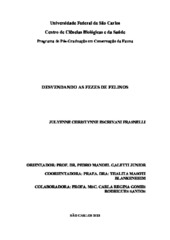| dc.contributor.author | Frasnelli, Julyenne Christynne Escrivani | |
| dc.date.accessioned | 2023-02-23T17:34:26Z | |
| dc.date.available | 2023-02-23T17:34:26Z | |
| dc.date.issued | 2023-02-03 | |
| dc.identifier.citation | FRASNELLI, Julyenne Christynne Escrivani. Desvendando as fezes de felinos. 2023. Dissertação (Mestrado em Conservação da Fauna) – Universidade Federal de São Carlos, São Carlos, 2023. Disponível em: https://repositorio.ufscar.br/handle/ufscar/17411. | * |
| dc.identifier.uri | https://repositorio.ufscar.br/handle/ufscar/17411 | |
| dc.description.abstract | Feline excreta have been the object of study for years by several researchers. This survey recorded the biological and behavioral aspects of the feces of this group of animals. Why is feces buried at certain times and left exposed at others? What are the meanings? Does domestication and human influence affect this act as well? The first chapter of this work aims to systematize this knowledge and answer the questions presented. In addition to a critical synthesis of this theme, differences and sanitary interference, another question: do owners know the atavistic needs of domestic cats and do they provide an environment endowed with well-being and safety? With that in mind, the second chapter of this work was developed on the theme of a manual with informal language, to teach cat lovers about their primary needs in urban homes, as well as the best way to interact with them, targeting their potential mesopredator species. In the third chapter, we developed a didactic material in a playful way for children between six and seven years old, demonstrating the different roles of feline feces, elucidating the differences between felines that are close (domestic cats) and free-living ones. This work aims to contribute to awareness, knowledge and respect for the needs of cats (including free-living ones) and to awaken interest in the conservation of this animal group. | eng |
| dc.description.sponsorship | Não recebi financiamento | por |
| dc.language.iso | por | por |
| dc.publisher | Universidade Federal de São Carlos | por |
| dc.rights | CC0 1.0 Universal | * |
| dc.rights.uri | http://creativecommons.org/publicdomain/zero/1.0/ | * |
| dc.subject | Excreção | por |
| dc.subject | Comportamento | por |
| dc.subject | Felidae | eng |
| dc.subject | Excretion | eng |
| dc.subject | Behavior | eng |
| dc.title | Desvendando as fezes de felinos | por |
| dc.title.alternative | Understanding feline feces | eng |
| dc.type | Dissertação | por |
| dc.contributor.advisor1 | Galetti Júnior, Pedro Manoel | |
| dc.contributor.advisor1Lattes | http://lattes.cnpq.br/7398754661670478 | por |
| dc.contributor.advisor-co1 | Blankenheim, Thalita Masoti | |
| dc.contributor.advisor-co1Lattes | http://lattes.cnpq.br/4940679178638369 | por |
| dc.description.resumo | As excretas dos felinos vêm sendo objeto de estudo há anos por vários pesquisadores. Esse levantamento observou os aspectos biológicos e comportamentais das fezes desse grupo de animais. Por que as fezes são enterradas em certos momentos e deixadas expostas em outros? Quais são os significados? A domesticação e influência humana interfere? Como esse conhecimento auxilia profissionais que lidam com gatos? O primeiro capítulo deste trabalho visa sistematizar esse conhecimento e responder os questionamentos apresentados. Além de uma síntese crítica desta temática, as diferenças e interferências levantou outro questionamento: os tutores conhecem as necessidades atávicas dos gatos domésticos e proporcionam um ambiente dotado de bem-estar e seguro? Pensando nisso, foi desenvolvido o segundo capítulo dessa obra na temática de um manual com linguagem informal, para ensinar os amantes de gatos sobre suas necessidades primordiais em lares urbanos, bem como a melhor forma de interagir com eles, visando seu potencial espécie mesopredadora. No terceiro capítulo, desenvolvemos um material didático de forma lúdica para as crianças entre seis e sete anos, demonstrando os diferentes papeis das fezes dos felinos, elucidando as diferenças existentes entre os felinos que estão próximos (gato doméstico) e os de vida livre. Este trabalho visa contribuir para a conscientização, conhecimento e respeito às necessidades dos gatos (incluindo os de vida livre) e despertar o interesse pela conservação deste grupo animal. | por |
| dc.publisher.initials | UFSCar | por |
| dc.publisher.program | Programa de Pós-Graduação em Conservação da Fauna - PPGCFau | por |
| dc.subject.cnpq | CIENCIAS AGRARIAS::RECURSOS FLORESTAIS E ENGENHARIA FLORESTAL::CONSERVACAO DA NATUREZA::CONSERVACAO DE AREAS SILVESTRES | por |
| dc.publisher.address | Câmpus São Carlos | por |
| dc.contributor.authorlattes | http://lattes.cnpq.br/5638118909152460 | por |

